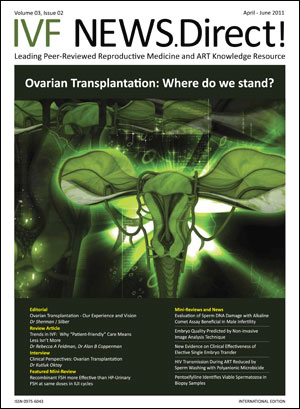Editorial by Dr. Sherman J. Silber, M.D.
IVF NEWS.Direct!, April/June 2011
Dr. Sherman J. Silber, a pioneer in microsurgery and infertility, is considered a leading authority on IVF, sperm retrieval, ICSI, vasectomy reversal, tubal ligation reversal, egg and embryo freezing, testicle and ovary freezing and transplantation, and the reproductive biological clock. He performed the world’s first microsurgical vasectomy reversal, as well as the first testicle transplant, in the 70’s, and the world’s first ovary transplant in the current century. He was the first to develop the TESE and MESA techniques for retrieving testicular and epididymal sperm in azoospermic men. He headed the clinical MIT team that first mapped and sequenced the Y chromosome in infertile men and helped to discover the now famous DAZ gene for male fertility. Recently, he has perfected the preservation of fertility for cancer patients with ovarian freezing and transplantation; thereby figured out how to extend the reproductive biological clock of women. He has also developed minimal ovarian stimulation protocols to reduce IVF costs.

Then time passed, and in 2003, I received a phone call from two identical twin sisters who had a similar problem, had searched the internet, and figured that if I could do this on these boys in the 1970s and 1980s, then I could do this for them also. We had already been freezing ovarian tissue for cancer patients since 1996, but of course, no one knew if this would ever benefit them since the prior studies on ovarian tissue freezing was only on animal models. These two identical twin sisters with one having normal ovarian function, and the other having gone through menopause by the age of 22 or earlier, began a series of ten such unusual cases, in which we perfected the technique to the point where it is now very robust with no oocyte loss to speak of. These ovarian grafts last longer than anyone could have imagined and we find no significant ischemic loss of follicles, but to accomplish this requires the use of proper surgical technique.
In fact, comparing microvascular transplant with no significant ischemia time, to the cortical technique in which it might take two or three days for full revascularization of the cortical graft, the technique we published, was equally effective in terms of the long duration of graft functions. The results in most centers were dreadfully scattered and not robust at all for frozen ovary grafts of cancer patients before we published our techniques. Fresh cortical grafting, if done correctly, is robust and works virtually all the time with a long duration of function; so then, what about the freezing using slow freeze techniques in these cancer patients?
So, we turned our attention to the cryopreservation technique, and discovered with in vitro viability studies that with the classic slow freeze methodology that everyone was using, over 70 per cent of the oocytes were rendered non-viable. Yet, with the vitrification technique that we developed for ovarian tissue cryopreservaton, there was no oocyte loss whatsoever, compared to fresh unfrozen controls. Now, we have created a very robust method for cancer patients to quickly and easily preserve their fertility, and for women with social indications only even, to extend their reproductive biological clock.
It is easier for them and for the oncologists than simple egg freezing,which we also helped to pioneer, because egg freezing would require many cycles of IVF, to give any assurance of future fertility, thereby losing precious time. Furthermore, with ovarian tissue freezing, instead of just 10 eggs or so, which, in humans, yields perhaps a 40% baby rate, the preservation of ovary tissue (using our vitrification technique) may help in saving hundreds of thousands of eggs.
Ovarian tissue freezing and then subsequent transplantation would restore not only the chance to have a baby, but would also re-establish hormonal function for the otherwise castrated woman. So, we now feel that we have a robust, no longer experimental, method for prolonging the reproductive lifespan of women, delaying menopause, and preserving the fertility of young cancer patients, who would otherwise be permanently sterilized by their curative treatment.
See also:

